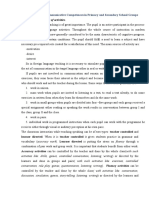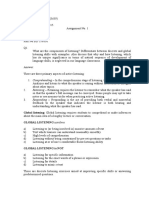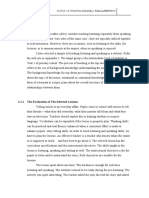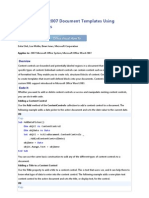0 ratings0% found this document useful (0 votes)
86 viewsTape Recorders, Role-Plays, and Turn-Taking in Large EFL Listening and Speaking Classes
Tape Recorders, Role-Plays, and Turn-Taking in Large EFL Listening and Speaking Classes
Uploaded by
LudmilsybillaThe document discusses challenges with using tape recorders and lack of student participation in large EFL listening and speaking classes. It proposes integrating listening and speaking activities using tape recorders and role-plays to give every student a chance to practice and participate. Specific techniques are outlined, such as having students answer listening questions into microphones and record responses, which allows the teacher to randomly select tapes for the class to hear without knowing who responded. Role-plays after listening are suggested to motivate students. Guidelines for speaking lessons include explaining strategies, assigning group discussions on engaging topics using roles, and having groups record discussions as homework for teacher feedback.
Copyright:
© All Rights Reserved
Available Formats
Download as PDF, TXT or read online from Scribd
Tape Recorders, Role-Plays, and Turn-Taking in Large EFL Listening and Speaking Classes
Tape Recorders, Role-Plays, and Turn-Taking in Large EFL Listening and Speaking Classes
Uploaded by
Ludmilsybilla0 ratings0% found this document useful (0 votes)
86 views6 pagesThe document discusses challenges with using tape recorders and lack of student participation in large EFL listening and speaking classes. It proposes integrating listening and speaking activities using tape recorders and role-plays to give every student a chance to practice and participate. Specific techniques are outlined, such as having students answer listening questions into microphones and record responses, which allows the teacher to randomly select tapes for the class to hear without knowing who responded. Role-plays after listening are suggested to motivate students. Guidelines for speaking lessons include explaining strategies, assigning group discussions on engaging topics using roles, and having groups record discussions as homework for teacher feedback.
Original Title
97-35-3-i
Copyright
© © All Rights Reserved
Available Formats
PDF, TXT or read online from Scribd
Share this document
Did you find this document useful?
Is this content inappropriate?
The document discusses challenges with using tape recorders and lack of student participation in large EFL listening and speaking classes. It proposes integrating listening and speaking activities using tape recorders and role-plays to give every student a chance to practice and participate. Specific techniques are outlined, such as having students answer listening questions into microphones and record responses, which allows the teacher to randomly select tapes for the class to hear without knowing who responded. Role-plays after listening are suggested to motivate students. Guidelines for speaking lessons include explaining strategies, assigning group discussions on engaging topics using roles, and having groups record discussions as homework for teacher feedback.
Copyright:
© All Rights Reserved
Available Formats
Download as PDF, TXT or read online from Scribd
Download as pdf or txt
0 ratings0% found this document useful (0 votes)
86 views6 pagesTape Recorders, Role-Plays, and Turn-Taking in Large EFL Listening and Speaking Classes
Tape Recorders, Role-Plays, and Turn-Taking in Large EFL Listening and Speaking Classes
Uploaded by
LudmilsybillaThe document discusses challenges with using tape recorders and lack of student participation in large EFL listening and speaking classes. It proposes integrating listening and speaking activities using tape recorders and role-plays to give every student a chance to practice and participate. Specific techniques are outlined, such as having students answer listening questions into microphones and record responses, which allows the teacher to randomly select tapes for the class to hear without knowing who responded. Role-plays after listening are suggested to motivate students. Guidelines for speaking lessons include explaining strategies, assigning group discussions on engaging topics using roles, and having groups record discussions as homework for teacher feedback.
Copyright:
© All Rights Reserved
Available Formats
Download as PDF, TXT or read online from Scribd
Download as pdf or txt
You are on page 1of 6
Tape Recorders, Role-Plays, and Turn-
Taking in Large EFL Listening and
Speaking Classes
By Xiao Haozhang
In the present EFL classroom, the teaching of listening and speaking relies heavily on the use of
the language lab or tape-recorders. It is generally agreed in China that the main reason for this is
that most EFL teachers are non-native English speakers and thus may lack proficiency in
English. However, in the classroom in which the tape recorder is used frequently there are some
common problems. For instance, teachers may just manipulate the "machine," supplemented by a
few comprehension questions after the students listen to the aural material. This can hinder the
intrinsic motivation of students. How much do students take in when they are faced with
"machines"? Normally, most of the teacher-posed questions are answered by the better students.
Meanwhile, the majority of students just remain silent and listen. Some may even feel bored and
sleepy. In such cases, how can we motivate all the students in the class to participate actively in
the listening lesson?
Unlike the listening classroom, native English speakers have been invited in recent years to teach
speaking. These teachers have made the speaking classroom more lively and have helped more
fluent student speakers. Yet we find that many students speak as poorly, if not worse, than those
we taught years ago. To find out why, we observed the lessons taught by the native English
teacher. After a few observations of the same class, we realized that only the better students took
the opportunities to talk in group work. And usually it was these students who spoke for most of
the discussion time. These students were able to monopolize discussions for the following
reasons:
The large size of the class: This makes it difficult for the teacher to control the whole
class in group work and to get feedback from all the students.
Affective factors: Some extroverted students tend to be talkative and learn better in oral
work, while the introverted ones remain quiet.
Lack of interesting authentic materials: Listening materials in China depend to a large
extent on the textbook. Even teachers who are very proficient in English are not
encouraged to make tapes of their own for the students.
Implementing Aural Tapes and Turn-taking
In order to enhance the speaking competence of our students in the oral communication
classroom, students must have sufficient comprehensible language input, most often through
language tapes. At the same time, language learning must be linked to meaningful language use
on the part of the learner in the communicative classroom. The language learning experience
must involve the expression of the learner's opinions and thoughts as s/he negotiates interactively
with other classmates and with the teacher.
Here personal investment is crucial. Some students in the classroom do not take the opportunity
to speak in group work or to respond actively after listening, partly because of a lack of roles to
play or turns to take and partly because of affective factors. One of the major obstacles in
learning to speak is "the anxiety generated over the risks of blurting things out that are wrong,
stupid or incomprehensible" (Brown 1994b: 255). The language ego here makes some students
fearful of being judged or teased by others. Some anxiety, however, is needed because it
contributes to learning in the classroom (Brown 1994a). The techniques here-implementing turn-
taking with the help of tape-recorders-can be very effective and practical for the teaching of both
listening and speaking. They can be achieved best by integrating listening and speaking.
The Teaching of Listening
Focusing on listening is particularly advantageous in large classes. Through proper speaking
activities, such as teacher-student interactions and student-student interactions, we can get
immediate feedback from the students and at the same time motivate them to listen more
attentively. How can we integrate listening with speaking with every student involved in a large
class? The following are the proposed procedures (for intermediate level) in the listening
classroom.
Pre-listening: Activity 1
Warmup questions: This activity can be done as pair work in quasi-communicative activities, the
goal of which is to relate students' prior knowledge (schemata) to the message they will listen to.
In this case, students may lower their affective filters, and have their respective turns to speak.
While-listening: Activity 2
After students listen to the message once or twice, the teacher may use pauses and ask questions
(using both bottom-up and top-down skills). Before asking questions, however, it is better for the
teacher to tell the students that everybody will be asked to respond. In this way, the students will
listen more attentively.
Activity 3
Teacher-led evaluation and self/peer evaluation can be done with the help of tape recorders or
through the integration of the language skills, as described below.
(a) The teacher asks listening comprehension questions one after another; all the students answer
them respectively through student microphones and simultaneously record their responses with
student tape recorders. Then, the teacher can ask any student (through teacher-to-individual
student calls) to play his/her tape to the class so that other students will not know who answered
the question. Then, teacher-led evaluations and self/pair evaluations follow. In this manner,
students learn in an uncompetitive situation, and thus lower their affective filters. Moreover,
every student in a large class can get a chance to practice.
(b) Self/pair evaluation can be done through the integration of listening with writing. Some
forms or blanks can be made beforehand by the teacher for the students to fill in after they listen
to the tape several times. And then, ask the students to check the answers in pairs with the help
of the teacher's feedback or correction.
Post-listening: Activity 4
Role-plays: Ask students to take roles in listening to conversations or dialogues. Role- playing
one of the speakers makes students listen more attentively to the speaker they will play. These
role-plays can be practiced in pairs or groups. Such speaking performance after listening can be
done in class, if time permits, or after class as homework, as required later in the sample task for
a speaking class.
The Teaching of Speaking
In contrast to the listening class, the focus of teaching speaking, of course, is to improve the oral
production of the students. Therefore, language teaching activities in the classroom should aim at
maximizing individual language use. This requires the teacher not only to create a warm and
humanistic classroom atmosphere, but also to provide each student with a turn to speak or a role
to play. Pair work and group work, therefore, are often implemented in the oral communication
class. Communicative language teaching, however, does not merely mean pair/group work.
Since learning and communication strategies form one of the components of communicative
competence, we should spend more time teaching speaking strategies, or communication
strategies which are normally ignored by EFL teachers. Our students need to learn not only
linguistic and sociolinguistic knowledge but also how to use speaking strategies to keep
conversations going.
In large EFL speaking classes, pair work and group work are often difficult to carry out
effectively due to affective factors and problems of logistics. Here too, tape-recorders and role-
plays come to our aid. First, we can use tapes to warm up or promote students' pair discussion
through songs, music, or sounds like whistling winds, breaking waves, and so forth. Then, we
can use role-plays in class to enable each student to speak. Generally, there is insufficient time
for each group in a big class to present their role-plays to the whole class. Homework, therefore,
should be assigned, as shown below.
Here are some guidelines for lesson planning, aimed at solving the aforementioned problem in
our large EFL speaking class:
Present and explain the speaking strategies.
In a large EFL class, speaking strategies, such as asking for clarification and using fillers
in order to gain time to process, etc., can first be introduced to the students by
exemplification. These strategies should be related to the topic to be discussed in class.
Provide a topic that engages the interest of the group and is educationally enriching.
Design a group task that involves some degree of discussion and uses the strategies
presented and explained by the teacher related to the topic.
Consider and specify the role each participant of the group can play in the group
discussion. Clear specifications are useful in avoiding problems, such as uneven
participation.
Specify the time allotted for group discussion and presentation of group views to the
class.
Provide adequate help to the students in the form of information, guidelines, or
vocabulary prior to or during the group discussion.
Employ the following homework procedure: (a) A task implementing the above guidance
should be given as homework to the students; (b) The oral group task should encourage
the use of authentic language in meaningful contexts; (c) Each group will record the oral
work of its members and submit the tape signed with their names to the teacher for
assessment; (d) The teacher gives feedback to the students and plays selected tapes to the
class.
The following is a sample of instructions for such a task.
Instructions: In the subsequent task you may use the following speaking strategies: description,
and fillers, such as well, er, you know , etc., to gain time to process your thoughts-just do not let
yourself stop.
Such strategies are divided into two kinds. One is based on the native language, such as
borrowing, literal translation, and coining ; the other is based on the target language, including
use of a general word, approximation, description, word coinage, appeal forassistance , etc.
(Cohen 1990).
In your group, suppose that you are members of a scholarship selection committee that is
responsible for interviewing and choosing one candidate to receive a scholarship for a
postgraduate degree in business administration in the USA. Each person in the group represents
one of the following:
a university lecturer representing the college;
a bank officer representing the bank that finances the scholarship;
a Chinese government official who recommended the candidates;
a Chinese businessman who is the future employer.
Candidate One
Wu Fang is 40 years old and has been working with the trade company for ten years. Before that
he taught in a middle school in the rural areas. He is physically fit and once trained in martial arts
for competitions. He has traveled widely. He has an 18 year-old son who is a college student
now. He likes business very much.
Candidate Two
Li Ping is 27 years old and is a translator in a joint venture company in Beijing. He graduated
from the Beijing Foreign Language Institute, where he obtained an MA. He has an excellent
academic record. He is single and lives with his parents. His parents took care of him when he
was very sickly in the university. He is still staying with them to take care of them because both
of them are in poor health.
Candidate Three
Tong Xi is supervisor of a department in a joint venture company. She was initially a foreign
language teacher in a college. She left teaching to start a small business in Shanghai. She sells
ladies' garments and started a small factory with a group of friends. She is divorced and has an
eight-year old daughter. Her parents do not live with her as they are more accustomed to country
life in Jiang Xi Province.
Conclusion
The program we designed has improved the teaching of oral communication in our large EFL
classes. It has the following advantages: (a) It capitalizes on the natural link between listening
and speaking; (b) It focuses on both language-based accuracy and message-based fluency,
interaction, and meaning; (c) It encourages the use of authentic language in meaningful and less
competitive contexts; (d) It provides appropriate feedback and correction; (e) It gives students
opportunities to initiate oral communication; (f) It encourages the development of speaking
strategies; and (g) It provides intrinsically motivating techniques. In short, it is an effective
program for the teaching of listening and speaking in our large EFL classrooms.
Xiao Haozhang is an EFL lecturer at Ji'an Teachers' College, Jiang Xi Province, China. He has
published essays on English teaching and poems.
References
Brown, H. D. 1994a. Principles of language learning and teaching. 3rd ed. Prentice Hall
Regents.
---. 1994b. Teaching by principles: An interactive approach to language pedagogy. 3rd
ed. Prentice Hall Regents.
Cohen, A. D. 1990. Language learning: Insights for learners, teachers, and researchers.
Newbury House Publishers.
Ur, P. 1984. Teaching listening comprehension. Cambridge: Cambridge University Press.
You might also like
- Speaking Tutor 3A TGDocument9 pagesSpeaking Tutor 3A TGVorn norin SophyraknyNo ratings yet
- Teaching English to Speakers of Other LanguagesFrom EverandTeaching English to Speakers of Other LanguagesRating: 3 out of 5 stars3/5 (1)
- Teaching Listening in EFL Classrooms in Senior High Schools in TaiwanDocument33 pagesTeaching Listening in EFL Classrooms in Senior High Schools in TaiwanEdward FungNo ratings yet
- Engle ZaDocument29 pagesEngle ZadoinaNo ratings yet
- How To Teach Speaking Activities To ESL StudentsDocument3 pagesHow To Teach Speaking Activities To ESL StudentsThias Arisiana100% (2)
- Teaching ListeningDocument15 pagesTeaching ListeningJennifer VanceNo ratings yet
- The Language Skills-I 5659Document25 pagesThe Language Skills-I 5659mubarak201160% (5)
- ГОС іспитDocument27 pagesГОС іспитAnna TarasovaNo ratings yet
- The Language Skills 1 TEFL AIOUDocument24 pagesThe Language Skills 1 TEFL AIOUPrince Kazmi100% (1)
- Didactical Uk yDocument15 pagesDidactical Uk yCarlitos FernandezNo ratings yet
- Improving The Teaching of Listening: AbstractDocument4 pagesImproving The Teaching of Listening: AbstractSiti Nur HamizahNo ratings yet
- Hoca Sınav KonularıDocument17 pagesHoca Sınav KonularıKadir ArıcıNo ratings yet
- The Most Important Information That I Have Learned From The Harmer's Chapter 6: Popular MethodologyDocument5 pagesThe Most Important Information That I Have Learned From The Harmer's Chapter 6: Popular MethodologySuciati NingrumNo ratings yet
- Humanising Language Teaching Magazine For Teachers and TeachDocument4 pagesHumanising Language Teaching Magazine For Teachers and TeachHidayah SallehNo ratings yet
- An Innovative Approach To Teaching English Listening and Speaking Skills As A Foreign Language in A Language Lab ClassroomDocument5 pagesAn Innovative Approach To Teaching English Listening and Speaking Skills As A Foreign Language in A Language Lab ClassroomNor HazimahNo ratings yet
- 9 Mistakes To Avoid When TeachingDocument4 pages9 Mistakes To Avoid When TeachingSonsaku HakufuNo ratings yet
- Listening Strategies and Applications in EFL Classroom: II. MotivationDocument34 pagesListening Strategies and Applications in EFL Classroom: II. MotivationCesar MartinezNo ratings yet
- Teaching Oral SkillsDocument16 pagesTeaching Oral SkillsRhea Mae Torres100% (2)
- Teaching Listening in EFL ClassroomsDocument32 pagesTeaching Listening in EFL ClassroomsJuvrianto Chrissunday JakobNo ratings yet
- Imanul Buqhariah AlmDocument4 pagesImanul Buqhariah AlmImam BuqhariNo ratings yet
- DidacticDocument11 pagesDidacticHajar De NeigeyouNo ratings yet
- Proposal Skripsi FKIP InggrisDocument18 pagesProposal Skripsi FKIP Inggrisbudijvc86% (14)
- Teaching Young Learners BBCDocument8 pagesTeaching Young Learners BBCKapt Edy Putra GaluhNo ratings yet
- Speaking ObservationDocument44 pagesSpeaking ObservationAndy Tenry SumagaNo ratings yet
- MetoDocument12 pagesMetoRana QuliyevaNo ratings yet
- Teaching TechiquesDocument56 pagesTeaching Techiquesmartin pontNo ratings yet
- Tefl MakalahDocument12 pagesTefl Makalahapi-283634669No ratings yet
- The Audio-Lingual Method and Silent Way - FinishDocument41 pagesThe Audio-Lingual Method and Silent Way - FinishJoanne Lian Li Fang100% (1)
- Audio LingualDocument16 pagesAudio LingualSyuhadahAzmanNo ratings yet
- A Task-Based Approach - Teachingenglish - British Council - BBCDocument2 pagesA Task-Based Approach - Teachingenglish - British Council - BBCmllekiwiNo ratings yet
- Language Acquisition Can Occur at ADocument5 pagesLanguage Acquisition Can Occur at Akebir kaderNo ratings yet
- Lesson 2. Teaching Oral Communication Skills (Listening and Speaking)Document6 pagesLesson 2. Teaching Oral Communication Skills (Listening and Speaking)BlodiMerNo ratings yet
- Elt NotesDocument18 pagesElt NotesafrawrrNo ratings yet
- Community Language LearningDocument8 pagesCommunity Language LearningShinta Ari HerdianaNo ratings yet
- Lecture 11. Teaching SpeakingDocument7 pagesLecture 11. Teaching SpeakingarailymoooNo ratings yet
- Teaching Approaches: Task-Based Learning: What Is TBL?Document5 pagesTeaching Approaches: Task-Based Learning: What Is TBL?Abdullah ArslanNo ratings yet
- PPG Module TSL3105 Topic 6 Planning Remedial & Enrichmt ActivitiesDocument7 pagesPPG Module TSL3105 Topic 6 Planning Remedial & Enrichmt ActivitiesMissBigHead100% (2)
- Task Base TeachingDocument3 pagesTask Base TeachingdangthanhhdNo ratings yet
- Teaching Methods and ApproachesDocument9 pagesTeaching Methods and ApproachesZahraa LotfyNo ratings yet
- FP Langs JiT 2019 No 1 FGDocument12 pagesFP Langs JiT 2019 No 1 FGsiphilendabani1No ratings yet
- питання для магістрівDocument95 pagesпитання для магістрівAnna TarasovaNo ratings yet
- EFL Methodology, Mistakes and Feedback: ITTT 003 © International TEFL Teacher Training 1Document25 pagesEFL Methodology, Mistakes and Feedback: ITTT 003 © International TEFL Teacher Training 1Minh TrầnNo ratings yet
- Module 3.3 - Speaking and WritingDocument19 pagesModule 3.3 - Speaking and WritingThuonggipNo ratings yet
- The Audio Lingual MethodDocument4 pagesThe Audio Lingual MethodVivian FernándezNo ratings yet
- Lecture Unit 3 Mod 3Document26 pagesLecture Unit 3 Mod 3del420No ratings yet
- Active Learning WorkshopDocument22 pagesActive Learning WorkshopNahla MohammadNo ratings yet
- 640923-03-5048/wan Zubaidah A. Rahman/HBET3503Document8 pages640923-03-5048/wan Zubaidah A. Rahman/HBET3503AsrarHana WaHuwaNo ratings yet
- Reflection On Professional ReportDocument13 pagesReflection On Professional ReportJess PhamNo ratings yet
- RÈN LUYỆN NGHIỆP VỤ SƯ PHẠMDocument11 pagesRÈN LUYỆN NGHIỆP VỤ SƯ PHẠMhorusjwNo ratings yet
- Main WorkDocument32 pagesMain WorkJoshua NyarkoNo ratings yet
- Quiz Elt Methods: InstructionDocument4 pagesQuiz Elt Methods: InstructionFayza Nashrillah KimNo ratings yet
- Methods of Teaching English - Elnaz SaghafiDocument5 pagesMethods of Teaching English - Elnaz SaghafiElnaz Saghafi IINo ratings yet
- IMPROVING STUDENTS' SPEAKING SKILL THROUGH DRAMA TECHNIQUE Chapter IDocument7 pagesIMPROVING STUDENTS' SPEAKING SKILL THROUGH DRAMA TECHNIQUE Chapter Idwi83% (6)
- Important Aspects of Yesterday's Meeting Suggested by YouDocument6 pagesImportant Aspects of Yesterday's Meeting Suggested by YouMasood Ibn UbaidNo ratings yet
- PPP Teaching MethodDocument3 pagesPPP Teaching MethodAmera SherifNo ratings yet
- Module 10 Preparing To TeachDocument8 pagesModule 10 Preparing To TeachJana VenterNo ratings yet
- Dunya 1, Why Teach Pronunciation - DunyaDocument10 pagesDunya 1, Why Teach Pronunciation - Dunyasamrand aminiNo ratings yet
- DSSB Vacancies 2024 Latest RecruitmentDocument30 pagesDSSB Vacancies 2024 Latest Recruitmentkumarbikash7898No ratings yet
- Juknis PORSEDIK PPG UNMDocument28 pagesJuknis PORSEDIK PPG UNMRihan Muhammad AlghifariNo ratings yet
- Lauren Nakache Resume 15Document4 pagesLauren Nakache Resume 15api-297293720100% (1)
- I. Phrasal Verbs: Combine A Word On The Left With Its Relevant Particle On The RightDocument8 pagesI. Phrasal Verbs: Combine A Word On The Left With Its Relevant Particle On The RightThúy An Trần GiaNo ratings yet
- КТП 2 кл 2022-2023 1 полугDocument4 pagesКТП 2 кл 2022-2023 1 полугкатяNo ratings yet
- Lecture 10 Qualitative Data AnalysisDocument21 pagesLecture 10 Qualitative Data AnalysisdagangiftyNo ratings yet
- Shang and Dorwick Dialogic JournalDocument3 pagesShang and Dorwick Dialogic Journalapi-272561188No ratings yet
- Listening: Name: - Class: - DateDocument4 pagesListening: Name: - Class: - DateErmiNo ratings yet
- CURRICULUM Map EditedDocument9 pagesCURRICULUM Map EditedMikee Tan100% (1)
- LEARNING ENGLISH TO YOUNG LEARNER THROUGH Art and CraftDocument11 pagesLEARNING ENGLISH TO YOUNG LEARNER THROUGH Art and CraftSuhar KholishNo ratings yet
- Adjectives - G 7Document11 pagesAdjectives - G 7Mar RichNo ratings yet
- Assignment For Ms Sam (Lesson Planning)Document3 pagesAssignment For Ms Sam (Lesson Planning)mylen romeroNo ratings yet
- Vowels Part 08Document13 pagesVowels Part 08Scharlene MuellerNo ratings yet
- Exceptions:: Good - Better Bad - Worse Far (Distance) - Farther Little - LessDocument1 pageExceptions:: Good - Better Bad - Worse Far (Distance) - Farther Little - LessBrian Alejandro Pineda CalzadoNo ratings yet
- Test Satzbau de LoesungDocument3 pagesTest Satzbau de LoesungcacbuNo ratings yet
- Dzexams 2as Anglais 875564Document5 pagesDzexams 2as Anglais 875564BOUHOUCHE AfafNo ratings yet
- 83 Superlative The OldestDocument3 pages83 Superlative The Oldestjoanne0049No ratings yet
- Oral Com SLHT q1 Week 1 2Document9 pagesOral Com SLHT q1 Week 1 2Christian Harrison LoloNo ratings yet
- Approaches To The Study of Word Meaning The Legacy of Historical SemanticsDocument44 pagesApproaches To The Study of Word Meaning The Legacy of Historical SemanticsAndreEa CiorneiNo ratings yet
- Building Word 2007 Document Templates Using Content ControlsDocument27 pagesBuilding Word 2007 Document Templates Using Content ControlsNanang Nasrullah TanNo ratings yet
- The Complete Literary Technique ListDocument21 pagesThe Complete Literary Technique ListEren SevinceNo ratings yet
- Prueba de Diagnostico Tercero MedioDocument2 pagesPrueba de Diagnostico Tercero MedioYorka Andrea Sepúlveda LabbéNo ratings yet
- The English Language Crystal David 1941 2. Ed. London U.A. 2002 London Penguin 9780141003962 Annas ArchiveDocument322 pagesThe English Language Crystal David 1941 2. Ed. London U.A. 2002 London Penguin 9780141003962 Annas ArchiveLisaNo ratings yet
- GRADE 8 TERM 2 2024 RATIONALIZED ENGLISH SCHEMES OF WORKDocument33 pagesGRADE 8 TERM 2 2024 RATIONALIZED ENGLISH SCHEMES OF WORKJob Makori OmbuiNo ratings yet
- English FAL P3 Grade 10 Nov 2018 MemoDocument12 pagesEnglish FAL P3 Grade 10 Nov 2018 MemoYomisNo ratings yet
- Structure Five: Workbook 1: Verb and Its ComplementationDocument9 pagesStructure Five: Workbook 1: Verb and Its ComplementationHuong Quynh HaNo ratings yet
- Non FictionDocument98 pagesNon FictionJhonna Marie SolisNo ratings yet
- Cadence Design With RTL Compiler Physical PDFDocument108 pagesCadence Design With RTL Compiler Physical PDFStudentNo ratings yet
- PTS Bahasa Inggris Kelas 7 ABCDocument4 pagesPTS Bahasa Inggris Kelas 7 ABCferryNo ratings yet
- Selling Skills For Real Estate AgentsDocument21 pagesSelling Skills For Real Estate AgentsLinkD ResourcesNo ratings yet

























































































